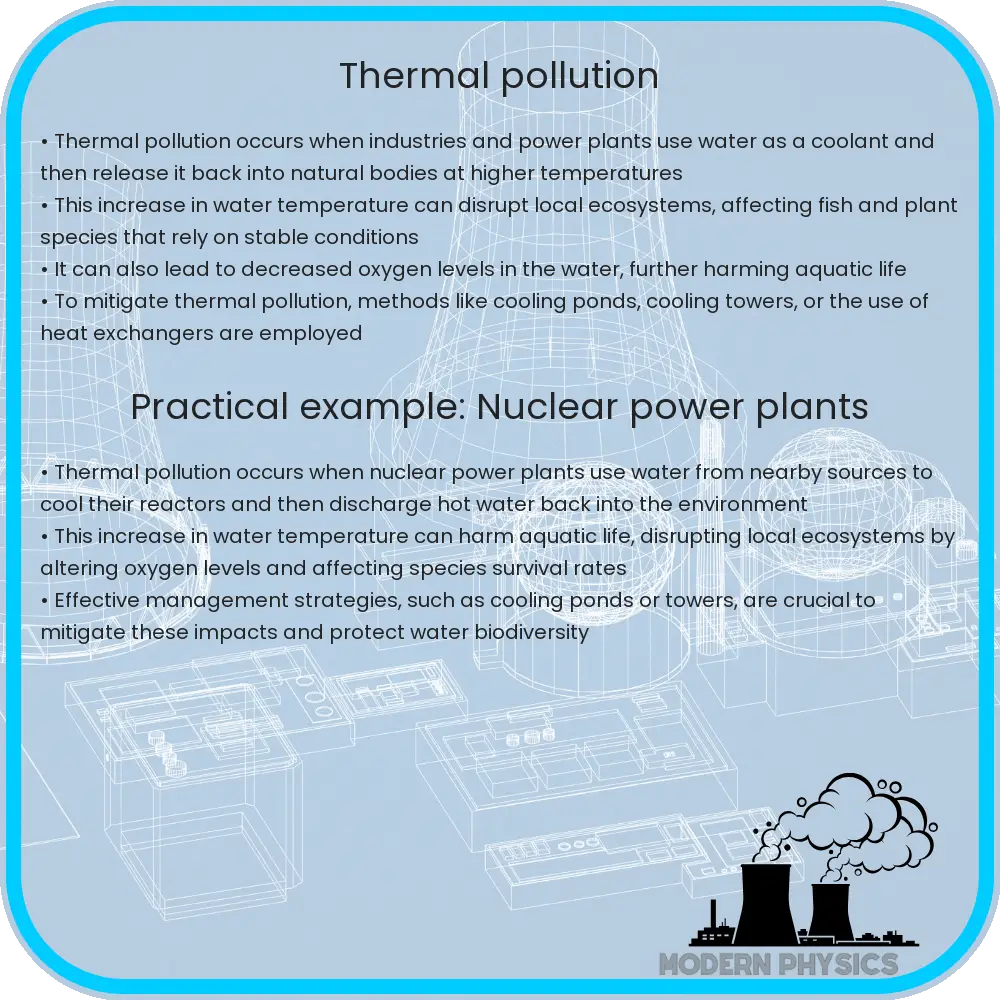Explore the impacts and solutions to thermal pollution, from technological innovations to global policies for preserving aquatic ecosystems.

Understanding Thermal Pollution: Its Impacts and Mitigation
Thermal pollution, often overlooked in environmental discussions, arises when an ecosystem’s temperature is altered by human activities. Predominantly, this is due to industrial processes where water used as a coolant is returned to the natural environment at a higher temperature. The ecological consequences are profound, affecting aquatic life and overall ecosystem balance.
Impact on Aquatic Ecosystems
One of the primary impacts of thermal pollution is on aquatic ecosystems. Elevated temperatures can lead to decreased oxygen levels in water, making it difficult for aquatic organisms to survive. Fish, amphibians, and other aquatic species are particularly vulnerable as they rely on specific temperature ranges for their metabolic processes. This stress can result in altered reproduction rates, migration patterns, and even mortality.
Thermodynamics and Heat Exchange
Understanding the thermodynamics of heat exchange is crucial in addressing thermal pollution. When industrial facilities use water as a coolant, they absorb heat energy, altering the water’s thermal properties. Upon returning this heated water to a natural body, it disrupts the thermal equilibrium. This change in temperature can be quantified using thermodynamic principles, offering insights into the extent of environmental impact.
Prevention and Control Measures
Preventing and controlling thermal pollution involves several strategies. One effective approach is using cooling ponds or towers, where heated water is stored and allowed to cool down before being released back into the environment. Additionally, implementing heat exchangers in industrial processes can significantly reduce the amount of heat transferred to the water.
- Recirculation systems that reuse water for cooling.
- Adoption of closed-loop cooling systems to minimize water intake and discharge.
- Regulatory measures enforcing strict temperature limits on industrial effluents.
Legislative and Policy Framework
Governments and environmental bodies play a crucial role in mitigating thermal pollution. Enforcing legislation that sets limits on permissible temperature increases in natural water bodies is essential. These policies should also encourage industries to adopt more sustainable cooling technologies.
In conclusion, addressing thermal pollution requires a multifaceted approach, encompassing thermodynamic understanding, technological solutions, and robust legal frameworks. The goal is to preserve aquatic ecosystems and maintain environmental balance.
Technological Innovations in Combating Thermal Pollution
Advancements in technology offer promising solutions to thermal pollution. Innovations such as high-efficiency cooling systems and renewable energy sources can reduce the reliance on traditional water-cooling methods. Embracing green technologies not only mitigates thermal pollution but also contributes to overall environmental sustainability.
Community Awareness and Education
Public awareness and education play a critical role in combating thermal pollution. Community involvement in environmental conservation can lead to greater accountability for industries and policymakers. Educating the public about the impacts of thermal pollution and ways to reduce their carbon footprint encourages a collective effort towards a healthier ecosystem.
Research and Continuous Monitoring
Continuous research and monitoring are essential for understanding the long-term effects of thermal pollution. Scientific studies provide valuable data on the impacts on wildlife, water quality, and ecosystem health. Regular monitoring helps in assessing the effectiveness of implemented measures and adapting strategies as needed.
Global Cooperation and Policy Harmonization
Thermal pollution is not confined by geographic boundaries, making international cooperation crucial. Harmonizing policies and sharing best practices globally can lead to more effective strategies. International agreements and treaties can play a significant role in standardizing regulations and promoting sustainable industrial practices.
- Encouraging multinational collaboration in environmental conservation.
- Developing global standards for industrial emissions and cooling systems.
- Promoting the exchange of technological innovations and sustainable practices.
Conclusion
Thermal pollution poses a significant threat to our aquatic ecosystems and overall environmental health. Its mitigation requires a comprehensive approach that includes technological advancements, legislative measures, public awareness, continuous research, and global cooperation. By integrating these elements, we can effectively address the challenges posed by thermal pollution, ensuring the preservation of our natural water bodies and the rich biodiversity they support. It’s not just an environmental imperative but also a responsibility we owe to future generations, to maintain the balance of our planet’s delicate ecosystems.
